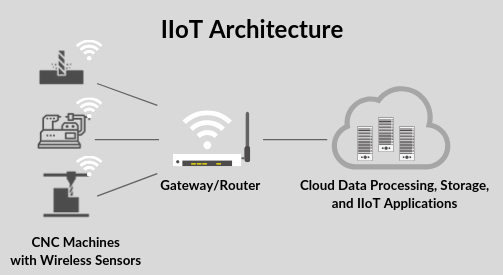The Anatomy of a CNC Machine IoT Solution
Industry 4.0 is bringing sweeping changes to manufacturing and IIoT is one of its enabling technologies. Early adopters are reaping the benefits.
With all new technologies, adoption is slower than the industry pundits would like people to believe. This is certainly true with one of Industry 4.0’s enabling technologies—the Internet of Things (IoT). In the manufacturing world, IoT is also known as the Industrial Internet of Things (IIoT), and it promises to shift the paradigm in the industry.

IIoT is a collection of technologies that include sensors, software, networks, cloud computing and analytics.
It is daunting knowing that the way we work today is going to change. It makes sense for manufacturers to be cautious, until there are proven use cases, before making the leap. That day is here.
Many early adopters are reaping the benefits of smart factories from implementing IIoT technologies. Bain & Co. research indicates that the industrial portion of the Internet of Things (IIoT)—including software, hardware and system solutions in the manufacturing, infrastructure, building and utilities sectors—continues to grow rapidly and could double in size to more than $200 billion by 2021.
Industry 4.0’s Connection to IIoT
Industry 4.0 is more than just a marketing term. It is a collection of technologies that bring sweeping changes to manufacturing. According to management consulting firm BCG, Industry 4.0 is an evolution that allows the gathering and analysis of data across machines, enabling faster, more flexible, and more efficient processes to produce higher-quality goods at reduced costs.
During the next decade, digital manufacturing technologies will enable companies to connect physical assets and create a flow of data across the value chain that will link every phase of the product life cycle, from design, sourcing, and production to distribution, point of sale, and the end user.
One of Industry 4.0’s enabling technologies is IIoT, which is a collection of technologies that include sensors, software, networks, cloud computing, and analytics. The combination of these elements makes every machine smart.
How IIoT Works
Every IIoT solution includes the following five basic functions:
- Data Collection: The primary form of data collection is through a sensor. Sensors continually monitor and collect data on energy usage as well as environmental and operational conditions such as temperature, vibration, time-to-complete, downtime, and more. Sensors will eventually become embedded in CNC machinery and become part of a standard offering.
For companies that want to take advantage of the benefits of IIoT today, replacing all existing machines with sensor-enabled equipment is often not an option. One low-cost alternative is to retrofit machines with external devices to make them IIoT-compatible. These devices bolt onto equipment and contain sensors, connectivity and control.

Industry 4.0 allows the gathering and analysis of data across machines. Manufacturers use that data to uncover patterns in machine operations.
- Connectivity: Sensors and retrofit devices connect to a network using hard-wired or wireless connections. Wireless installations remove the cost and complexity associated with dedicated wiring and allows machines to be placed in areas where wiring is limited or too costly to implement.
Common wireless protocols used in IIoT are cellular, WiFi, Near Field Communication (NFC), Zigbee, and Bluetooth (low energy). Choosing which protocol to use is dependent on a variety of factors including environment, distance, location, IIoT platform, and more.
- Edge Computing: Massive amounts of data are collected from machines and can put a strain on networks. It is much more efficient to pre-process data on a device and send to the cloud for storage only the data that has value. The network manager, also referred to as the gateway or router, is a software and hardware device that sits at the edge of the IIoT network and between the factory and internet/cloud. It is the connection point between the factory and the cloud platform.
The software that controls the network manager/gateway performs several functions. It aggregates and pre-processes data collected from sensors and IIoT devices before sending it to the cloud for storage and for use in IIoT applications. It also receives data and instructions from IIoT applications that are passed back to IIoT devices that can trigger some type of action in machines, such as shutting them down.
- Cloud Data Processing and Storage: Data needs to be stored for use in IIoT applications. Manufacturers use that data to uncover patterns in machine operations. For example, perhaps every day at 2 p.m. certain machinery experiences vibrations or there is an unexplained lull in production. Once that trend is discovered, the root cause can be uncovered and action can be taken to correct it.
Only cloud computing has the potential to scale quickly as well as store and process the volumes of data that IIoT generates. It is too costly to do on site.

Only cloud computing has the potential to scale quickly as well as store and process the volumes of data that IIoT generates.
- IIoT Applications: Applications such as remote monitoring and predictive maintenance analyze the collected data and present the results in a dashboard format. A dashboard is the primary user interface that provides an easy way to understand complex data. It displays key performance indicators (KPIs) such as efficiencies/inefficiencies and other metrics in a graphical or user-friendly way. It presents insight about machine operations to guide future decisions.
Now is a good time to learn more about IIoT and understand the investment needed to take advantage of the benefits garnered by implementing smart technologies. The IIoT will increase efficiencies of CNC machines, helping to lower wastage and lower costs. It also decreases downtime with predictive maintenance. Increased efficiencies and reduced downtime translate to more profitability.
Hardinge Inc. | 800-843-8801 | hardinge.com
About the Author
Martin Nobs
Martin Nobs is Global System Architect at Hardinge Inc., an international provider of advanced metalcutting solutions, including CNC turning, milling and grinding machines, as well as workholding and machine tool accessories.
Related Content
Precision Machining Technology Review January 2023: Automation & Robots
Production Machining’s January 2023 showcase includes some of the latest technology from ABB, Mini-Mover Conveyors, FANUC, OnRobot, ATI Industrial Automation and FOBA Laser Marking+Engraving.
Read MoreHigh-Production Multitasking Becoming More Flexible
Rotary transfer machines remain well-suited for high-volume production, but are now more accommodating to smaller batch sizes.
Read MoreInside the Premium Machine Shop Making Fasteners
AMPG can’t help but take risks — its management doesn’t know how to run machines. But these risks have enabled it to become a runaway success in its market.
Read MorePrecision Machining Technology Review October 2023
Production Machining’s October 2023 technology showcase includes some of the latest technology from Tungaloy-NTK America Inc., Renishaw, Walter USA, Seco Tools and Haimer USA.
Read MoreRead Next
Preparing the Troops for the Coming Revolution
Manufacturers wishing to capitalize on the revolution will require a new level of knowledge, aptitude and disciplines in four key areas.
Read MoreDo You Have Single Points of Failure?
Plans need to be in place before a catastrophic event occurs.
Read MoreSeeing Automated Workpiece Measurement in Real Time
User-friendly inspection software for CNC machining centers was shown at IMTS 2024 monitoring measurements between and after machining while performing SPC based on recorded measurement values.
Read More
















.jpg;maxWidth=300;quality=90)







